DNR's Scott Johnson Earns Osborn Lifetime Achievement Award
 The Chase S. Osborn Award for Wildlife Conservation is presented by Purdue Forestry and Natural Resources to an individual who by writing, research, teaching or other personal accomplishments has made significant contributions to wildlife conservation in the state of Indiana.
The Chase S. Osborn Award for Wildlife Conservation is presented by Purdue Forestry and Natural Resources to an individual who by writing, research, teaching or other personal accomplishments has made significant contributions to wildlife conservation in the state of Indiana.
Scott Johnson, recipient of the 2022 Osborn Lifetime Achievement Award, epitomizes everything the award stands for. Johnson has served the Indiana Department of Natural Resources for the last 35 years, as a nongame mammalogist, wildlife science program manager, and most recently, wildlife science supervisor. He has worked on management and conservation projects as well as educational efforts on a variety of species across the state from Franklin's ground squirrels and bats to river otters, bobcats and Allegheny woodrats to name a few.
Johnson came to the DNR after earning his bachelor's degree from Ohio University in 1980 and a master's degree at the University of Wisconsin-Steven's Point in 1984. He began his career as a wildlife research associate with the Wisconsin Cooperative Wildlife Research Unit in Madison, Wisconsin, before hiring on with the Indiana DNR in December of 1986. The Warren, Ohio, native has since become a stalwart for conservation in Indiana, while becoming one of the foremost experts on white nose syndrome in bats and other bat conservation, management and research topics in the state.
His career efforts have earned him recognition from The Midwest Bat Working Group (Dave Redell Lifetime Achievement Award 2017), the Indiana Chapter of the Wildlife Society (Hoosier Wildlife Award 2019), the Sassafras Audubon Society (Lifetime Conservationist Award 2019) and the Indiana Wildlife Federation (Wildlife Conservationist of the Year 1997).
"I was fortunate to come on at a time when nongame wildlife programs were relatively new, not only in Indiana, but nationally," Johnson explains. "With the environmental movement, the passage of the Endangered Species Act and Clean Air Act, concern for the environment in general and the species that environment supports blossomed at that time and it has only continued to grow since I've been around. Many states didn't have, or were just starting, programs to conserve endangered species or nongame wildlife so there was a blank slate. There was so much work to do, and I was fortunate to have supervisors and leadership that gave me the freedom to do the things I felt needed to be done."
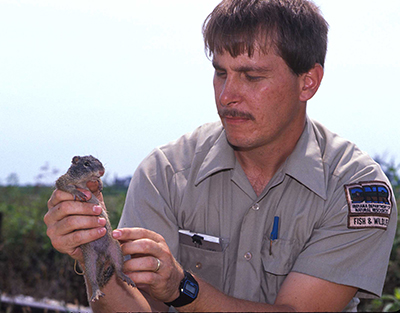 Johnson's impact on wildlife in Indiana began with his first assignment with the Division of Fish and Wildlife, a project with the Franklin's ground squirrel, which are found in Northwest Indiana. Johnson picked up the live trapping project began by his predecessor at the DNR and was able to document a range reduction for the species. Conservation efforts for this species in Indiana continue today.
Johnson's impact on wildlife in Indiana began with his first assignment with the Division of Fish and Wildlife, a project with the Franklin's ground squirrel, which are found in Northwest Indiana. Johnson picked up the live trapping project began by his predecessor at the DNR and was able to document a range reduction for the species. Conservation efforts for this species in Indiana continue today.
Johnson's next project on management of Indiana bats would become the launching pad for a career's worth of work. Back in the 1980s, more than half of the Indiana bats known to exist in the Indiana hibernated in caves. It is called the Indiana bat because the first specimen described to science in 1928 was based on a specimen found Wyandotte Cave in Leavenworth, Indiana. The site featured nearly 10,000 of the federally endangered bats, part of a population of about 100,000 including other caves in the area, which drew a lot of attention in terms of protecting the caves and the bats within them.
Johnson and his colleagues learned how to count bats to keep track of the population as well as various methods that can be used to protect the delicate cave habitat. He also has assisted in the advance of monitoring and protection technology.
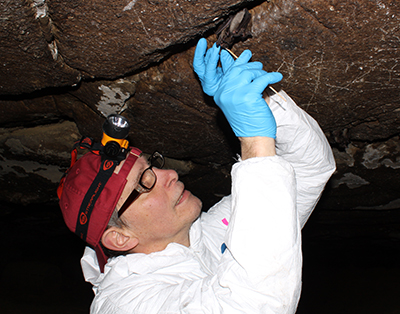 "I can't take credit for it," Johnson said, "but I got to know a few people in the caving environment and one of the cavers was an engineer. We used to hold up a measuring tape to try to measure the surface area of a cluster (of bats) in a cave from 10 feet away and that is how we would eyeball the cluster. We would say, the density is 400 bats per square foot, that looks like about 10 square feet, that's X number of bats. The engineer designed a set of laser calipers that projects a line of three red dots spaced six inches apart, which allowed for a far more accurate estimate of the size of the cluster. Today, we go in with cameras and photograph the big clusters and bring them into a GIS platform and then click on the noses. You can get an accurate and precise estimate of the size of the population that way. That is a huge advancement and another way we look to do surveillance for white nose syndrome. We can't see it 60 feet away, but we can see it when we blow up the image on a computer screen."
"I can't take credit for it," Johnson said, "but I got to know a few people in the caving environment and one of the cavers was an engineer. We used to hold up a measuring tape to try to measure the surface area of a cluster (of bats) in a cave from 10 feet away and that is how we would eyeball the cluster. We would say, the density is 400 bats per square foot, that looks like about 10 square feet, that's X number of bats. The engineer designed a set of laser calipers that projects a line of three red dots spaced six inches apart, which allowed for a far more accurate estimate of the size of the cluster. Today, we go in with cameras and photograph the big clusters and bring them into a GIS platform and then click on the noses. You can get an accurate and precise estimate of the size of the population that way. That is a huge advancement and another way we look to do surveillance for white nose syndrome. We can't see it 60 feet away, but we can see it when we blow up the image on a computer screen."
According to the National Wildlife Heath Center, white nose syndrome is a fungal disease that infects the skins of the muzzle, ears and wing membranes of hibernating bats. Infected bats can experience weight loss, dehydration, electrolyte imbalances and even death.
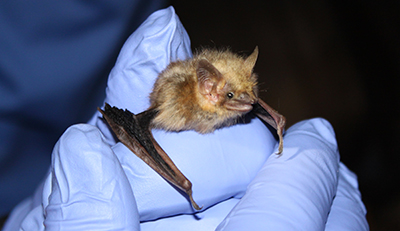 To protect the bats during hibernation, Johnson and his colleagues installed angle iron "bat-friendly" gates at several caves with large populations. This steel gate, built out of angle iron with the long row of bars positioned like church steeple, protects the bats from unwanted visitors, while allowing airflow into and out of the cave and cool air to come into the cave so bats can hibernate efficiently.
To protect the bats during hibernation, Johnson and his colleagues installed angle iron "bat-friendly" gates at several caves with large populations. This steel gate, built out of angle iron with the long row of bars positioned like church steeple, protects the bats from unwanted visitors, while allowing airflow into and out of the cave and cool air to come into the cave so bats can hibernate efficiently.
In addition to protecting the bats from human visitation and using surveillance to monitor and count the bat population, Johnson has worked to educate the public on the importance of bats.
"Bats are probably one of the most maligned and misunderstood groups, but that attitude is changing," Johnson explains. "We're just beginning to realize how much a positive impact they have on the environment. We always knew they had an impact on agricultural pests. What's not know is some of the impacts they have on forest pests. Big brown bats, for example, eat the spotted cucumber beetle. The larval form of that is the southern corn rootworm, which is a huge agricultural pest. Big brown bats munch on the breeding adults, which has a huge positive impact to the farmers here in Indiana and in the Midwest."
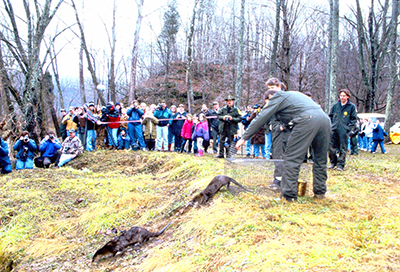 In the mid-1990s, the Indiana River Otter Restoration project occupied Johnson's time. The effort, which eventually brought more than 300 otters to the state over a five-year span, began with a habitat assessment that identified six watersheds in Indiana that were suitable for otters. From there, Johnson and his colleagues made yearly trips to Theriot, Louisiana, to see Leroy Sevin on the Bayou Otter Farm. The team would load up 75 wild-caught river otters Sevin had captured for reintroduction into trailers and begin the journey back to Indiana. The Purdue School of Veterinary Medicine staff, led by Dr. Wally Morrison, then volunteered their time and medical expertise to fix any injuries, anesthetize them and allow Johnson and his staff to mark them with ear and web tags and take measurements. During the following days, the otters were transported to release sites, where the public could get up close and personal to Indiana's newest wildlife residents.
In the mid-1990s, the Indiana River Otter Restoration project occupied Johnson's time. The effort, which eventually brought more than 300 otters to the state over a five-year span, began with a habitat assessment that identified six watersheds in Indiana that were suitable for otters. From there, Johnson and his colleagues made yearly trips to Theriot, Louisiana, to see Leroy Sevin on the Bayou Otter Farm. The team would load up 75 wild-caught river otters Sevin had captured for reintroduction into trailers and begin the journey back to Indiana. The Purdue School of Veterinary Medicine staff, led by Dr. Wally Morrison, then volunteered their time and medical expertise to fix any injuries, anesthetize them and allow Johnson and his staff to mark them with ear and web tags and take measurements. During the following days, the otters were transported to release sites, where the public could get up close and personal to Indiana's newest wildlife residents.
"That has been a really successful effort and was a really enjoyable project," Johnson recalls. "We had a lot of public support for that. A lot of school children were involved in it as they could sponsor an otter. There were a lot of educational and outreach efforts that went into bringing river otters back to Indiana. It was a good opportunity for locals to see wildlife up close. School buses of children came to see the releases. We also released some on private lands. We released them on 12 sites in nine counties, but otters are now statewide. There was sequential expansion."
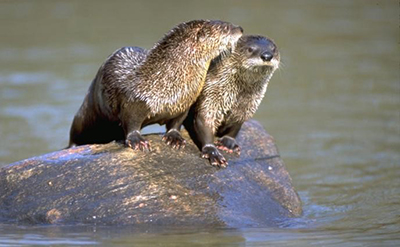 In addition to increasing the otter population, Johnson and his colleagues learned a lot about the species through radio transmitters and even documented reproduction within the first year. They found that contrary to commonly held beliefs that otters bred when they were approaching their second birthday that they actual do so a year earlier. They have delayed implantation, so they mate in March/early April, but the embryos do not implant right away; they free float for 10 months before implanting in November or December and beginning a two-month gestation period. The female then gives birth in February or early March.
In addition to increasing the otter population, Johnson and his colleagues learned a lot about the species through radio transmitters and even documented reproduction within the first year. They found that contrary to commonly held beliefs that otters bred when they were approaching their second birthday that they actual do so a year earlier. They have delayed implantation, so they mate in March/early April, but the embryos do not implant right away; they free float for 10 months before implanting in November or December and beginning a two-month gestation period. The female then gives birth in February or early March.
From 1998 to 2006, Johnson completed a life history study on bobcats, which were listed as endangered at the state level at the time. With only a handful of confirmed records of bobcats in Indiana, researchers began a field study looking for specimens within the state and live trapping the animals with hopes of learning more about what they need in terms of food and habitat, etc., and simply what they were doing in Indiana. Trapped animals were radio collared to track movement, some of which was done via helicopter once a week, while stomach contents were collected from any mortalities to study food habits.
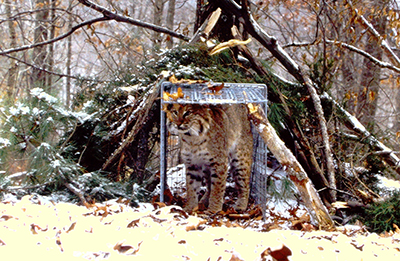 "It was fun," Johnson said. "It's really a jolt of adrenaline when you turn the corner and you have a 30-pound male bobcat looking at you in a box trap. They really took us for a ride though. We had radioed bobcats go to St. Louis, to Michigan, to downtown Cincinnati. They, young males typically, touched all the adjacent states. We generated a lot of information about the population and have really good information on dispersal and food habits. We accumulated a lot of information from that study. In fact, we still have some folks at Purdue working on the telemetry data that we didn't have time to analyze."
"It was fun," Johnson said. "It's really a jolt of adrenaline when you turn the corner and you have a 30-pound male bobcat looking at you in a box trap. They really took us for a ride though. We had radioed bobcats go to St. Louis, to Michigan, to downtown Cincinnati. They, young males typically, touched all the adjacent states. We generated a lot of information about the population and have really good information on dispersal and food habits. We accumulated a lot of information from that study. In fact, we still have some folks at Purdue working on the telemetry data that we didn't have time to analyze."
The final species that Johnson had a particular focus on was the Allegheny woodrat, which has a highly specific habitat of limestone and sandstone vertical cliffs with ledges and crevices located in a handful of counties along the Ohio River. With the spatially isolated population, genetic fragmentation, or inbreeding, can occur, which can bring negative results. To increase genetic diversity, a captive breeding program was established. Several FNR affiliated individuals, including Dr. Gene Rhodes, Dr. Rob Swihart and PhD alumnus Tim Smyser, assisted with the project along with former Purdue parasitologist Kevin Kazacos.
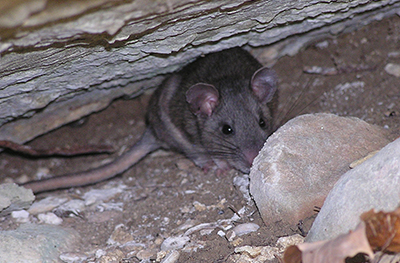 "The word rat has the same negative connotations as bat, but they're the cutest things ever, like a giant, oversized mouse, almost hamster-like," Johnson said. "We got to a point in 2007 where our populations were doing pretty well and we backed off a bit, but then they started to spiral down again. We realized that if we're going to keep Allegheny woodrats in Indiana, it was going to take some work, so we still have projects going on with them."
"The word rat has the same negative connotations as bat, but they're the cutest things ever, like a giant, oversized mouse, almost hamster-like," Johnson said. "We got to a point in 2007 where our populations were doing pretty well and we backed off a bit, but then they started to spiral down again. We realized that if we're going to keep Allegheny woodrats in Indiana, it was going to take some work, so we still have projects going on with them."
After spending 30 years as a nongame mammalogist out in the field, Johnson was promoted to wildlife science program manager in 2015, a role in which he managed a staff of 20 natural resource professionals and a budget of more than $2 million and supervised statewide conservation and management programs. In 2019, he was promoted to wildlife science supervisor. For the last eight years, Johnson has served as Indiana's Endangered Species Coordinator, a role through which he has seen several conservation victories.
"We are close to about 50 different species that we've either delisted or down listed and that's a measure of success," Johnson shared proudly. "Some of those are where we just collected enough information over time to realize they were not really in danger, whereas others we have made a concerted effort to restore them. Endangered species management is a bit like emergency room medicine. It is pricey. If you could have gone to the doctor annually, you wouldn't be in this shape. There are some real successes, but there are some real challenges still. It takes time, money, commitment and expertise to help these things out."
A big factor in ensuring that the state has the funding for conservation and restoration projects is the Indiana Nongame Wildlife Fund, made possible by the contributions from the public. The fund, which was created in 1982, is dedicated to supporting native species and nongame endangered species conservation in the state.
"The successes and fun projects are really rewarding, but you don't do it alone," Johnson emphasized. "I mentioned specifically folks at Purdue that have been helping, but I would be remiss if I didn't mention all of the people in Indiana that have helped because they contributed to the fund. Many of the things we have been able to accomplish wouldn't have been possible without their monetary donations. They have contributed over $13 million to the greater good the last 40 years. Also, Indiana is mostly privately owned, so without the individual landowners who have allowed us to access to their property to check on hibernating bats or swamp rabbits or whatever species, these successes would not have been possible."
 While Johnson and his colleagues have made many conservation gains over the years, it was difficult for him to accept his place among Chase Osborn Award recipients.
While Johnson and his colleagues have made many conservation gains over the years, it was difficult for him to accept his place among Chase Osborn Award recipients.
"When I first heard I was receiving this award, I went on the website to see what it was about and who the other recipients were, and that was pretty humbling," Johnson said. "There are some giants of Indiana conservation on that list, so I was very surprised. I didn't see this coming at all. When he called to tell me I had been selected for the award, Rob Swihart said 'you are receiving this award because you have made an impact.' For it to come from him, someone that I look up to a lot, that speaks volumes. It does hit home all that we have accomplished when it is said like that."
But again, Johnson is quick to deflect attention to the many individuals who have supported him, whether in the field or at home.
"A single individual gets the award, but you really don't get anywhere in this profession without the support and involvement from others," he shared. "Everything that I may have been recognized for, I didn't do it alone. There were a lot of folks involved from Purdue, as well as state and federal agencies, other entities in the state, the public, all of them made these things possible. Obviously my peers and colleagues and the leadership of the Division of Fish and Wildlife provided support and enthusiasm to do the things we have accomplished.
"I would also like to recognize my family. My wife Julie has been a support staff for me and a real partner in all of this. We have two sons, Dustin and Eric, and I would like to say thank you to them for putting up with those long trips to Louisiana or the days and nights of coming home late. They were always there for me."






